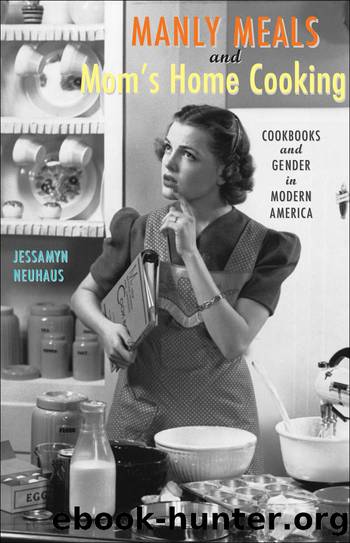Manly Meals and Mom's Home Cooking by Jessamyn Neuhaus

Author:Jessamyn Neuhaus
Language: eng
Format: epub
Publisher: Johns Hopkins University Press
Published: 2003-09-15T00:00:00+00:00
Figure 16 In the 1950s local and national televised cookery shows, building on the popularity of radio cooking shows in the 1930s, proliferated. Pictured here is Pearl Silverson, who hosted the Kitchen Magic cooking show out of Memphis, Tennessee. From William A. Kaufman, ed., Cooking with the Experts (New York: Random House, 1955).
Dining à la TV changed how many Americans ate in the postwar years, but in some ways home cooking in the United States did not change at all. Simply because television demanded new, more casual dining and because processed foods increasingly appeared at the dinner table did not mean that the basic compositionâmeat main dish, a starch side, a vegetable, and a dessertâof a home-cooked meal changed. Even TV dinners followed a similar composition. Moreover, we cannot assume that because certain types of recipes proliferated in the postwar period (especially those produced by processed food companies) Americans regularly followed those recipes. Some cookbook readers may have tried Betty Crockerâs bologna soup, but many probably did not. Certainly, some food writers and columnists complained about the state of American cuisine in the 1950s. For example, caterer, columnist, and cookbook author Helen Evans Brown (who enjoyed a long correspondence with James Beard in the 1950s) scorned highly processed foods. She once described many of the salty snacks often served at postwar cocktail parties as âviolently artificially colored, and not a few of them apparently flavored with soot, soap, or stale pepper.â54
Those not directly involved in the food business also complained. In her 1954 memoir about family life on an island near Seattle, humorist Betty MacDonald wrote about having to choke down absurd combinations of food at feminine gatherings. She also criticized and satirized radio and domestic magazine food writers: âAnother female house-hold hinter gave a recipe for a big hearty dish of elbow macaroni, mint jelly, lima beans, mayonnaise and cheese baked until âhot and yummy.â Unless my taste buds are paralyzed, this dish could be baked until hell freezes over and it might get hot but never âyummy.ââ MacDonald surely did not speak for herself only when she complained about these recipe purveyors and about the kind of food served at âladies onlyâ social events. She scornfully described one such salad as âtuna fish and marshmallows and walnuts and pimento (just for the pretty color, our hostess explained later when she was giving us the recipe) and chunks of pure white lettuce and boiled dressing.â âI almost gagged,â MacDonald stated shortly.55 The fact that Betty MacDonald encountered such food often enough to complain about it indicated its regular appearance at such gatherings. But on the other hand, her critical remarks about these kinds of recipes and the people who created them also showed that Americans did not uniformly accept strange and terrible combinations of processed foods.
Signs of use in cookbooks can reveal, in fragmentary ways, the many different ways individual Americans responded to recipes in the 1950s. For example, one woman who owned a copy of the strictly âhome
Download
This site does not store any files on its server. We only index and link to content provided by other sites. Please contact the content providers to delete copyright contents if any and email us, we'll remove relevant links or contents immediately.
A Cultural History of Work in the Age of Empire by Victoria E. Thompson (ed.)(298)
A Rome of One's Own by Emma Southon(277)
Executive Order No. 9066: The Terrible Injustice Of 1942 by Sollace Freeman(271)
The Evidence of Things Not Seen by James Baldwin(268)
The Explorers by Amanda Bellows(246)
Respectability and Reform by Tara M. McCarthy(243)
A Wider Type of Freedom: How Struggles for Racial Justice Liberate Everyone by Daniel Martinez HoSang(221)
The Grey Eagles of Chippewa Falls by John E. Kinville(191)
Liberty's Dawn: A People's History of the Industrial Revolution by Emma Griffin(190)
Rethinking White Societies in Southern Africa by Duncan Money(190)
Letters From London by Julian Barnes(185)
The Crosswinds of Freedom by James MacGregor Burns(182)
A Troublemaker May Surprise (The Troublemaker Series Book 2) by Genta Sebastian(175)
Evolution of Slavery Through the Ages: A Comprehensive World History of Slavery by PRESS VERITY(168)
A Teacher's Guide to Ladies of Liberty by Cokie Roberts Amy Jurskis(160)
Continental Strangers by Gemunden Gerd;(160)
The Slave Ship, Memory and the Origin of Modernity by Martyn Hudson(152)
Beware the Masher by Kerry Segrave(143)
Hunger Dark Pen by Dark Pen(141)
